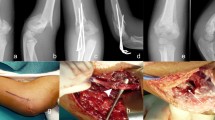Abstract
Objective
The incomplete supracondylar fracture of distal humerus poses difficulty for diagnosis. A shaft-condylar angle and a lateral capitellohumeral angle, which can be measured from a routine lateral view of plain film of the injured elbow, may be a clue to assist in the diagnosis. Nevertheless, no literature explains about the accuracy of these angles for diagnosis. Our goal is to investigate the accuracy, sensitivity, specificity, positive predictive value and negative predictive value of the shaft-condylar angle and the lateral capitellohumeral angle for diagnosis of the incomplete supracondylar fracture.
Methods
The retrospective study in tertiary care hospital was performed from January, 2014, to January, 2018. The patients aged below 15 years with elbow injury were recruited. The patients with complete fracture were excluded. The rest of the patients were divided into four groups which consisted of incomplete fracture and non-fracture group. With the shaft-condylar angle at 40° and the lateral capitellohumeral angle at 50°, the diagnostic accuracy of both angles were calculated.
Results
A total number of patients were 53. For the SCA, the accuracy was 92%, the sensitivity was 76%, the specificity was 93%, the positive predictive value was 92% and the negative predictive value was 93%. For the LCHA, the accuracy was 70%, the sensitivity was 55%, the specificity was 72%, the positive predictive value was 67% and a negative predictive value was 72%.
Conclusion
The shaft-condylar angle less than 40° in lateral elbow film might be a useful tool for diagnosis of the incomplete supracondylar fracture in pediatric patients with elbow injury.




Similar content being viewed by others
References
Cheng JC, Lam TP, Maffulli N (2001) Epidemiological features of supracondylar fractures of the humerus in Chinese children. J Pediatr Orthop B 10(1):63–67
Wilkins KE (1990) Residuals of elbow trauma in children. Orthop Clin N Am 21(2):291–314
Mahan ST, May CD, Kocher MS (2007) Operative management of displaced flexion supracondylar humerus fractures in children. J Pediatr Orthop 27(5):551–556. https://doi.org/10.1097/01.bpb.0000279032.04892.6c
Gartland JJ (1959) Management of supracondylar fractures of the humerus in children. Surg Gynecol Obstet 109(2):145–154
Suangyanon P, Chalayon O, Worawuthangkul K, Kaewpornsawan K, Ariyawatkul T, Eamsobhana P (2018) Pediatric elbow measurement parameters: evaluation of the six angles in inter- and intra-observer reliability. J Clin Orthop Trauma. https://doi.org/10.1016/j.jcot.2018.07.019
Madjar-Simic I, Talic-Tanovic A, Hadziahmetovic Z, Sarac-Hadzihalilovic A (2012) Radiographic assessment in the treatment of supracondylar humerus fractures in children. Acta Inform Med 20(3):154–159. https://doi.org/10.5455/aim.2012.20.154-159
Vaquero-Picado A, González-Morán G, Moraleda L (2018) Management of supracondylar fractures of the humerus in children. EFORT Open Rev 3(10):526–540. https://doi.org/10.1302/2058-5241.3.170049
Shrader MW, Campbell MD, Jacofsky DJ (2008) Accuracy of emergency room physicians’ interpretation of elbow fractures in children. Orthopedics 31(12)
Yildirim AO, Unal VS, Oken OF, Gulcek M, Ozsular M, Ucaner A (2009) Timing of surgical treatment for type III supracondylar humerus fractures in pediatric patients. J Child Orthop 3(4):265–269. https://doi.org/10.1007/s11832-009-0189-2
Herman MJ, Boardman MJ, Hoover JR, Chafetz RS (2009) Relationship of the anterior humeral line to the capitellar ossific nucleus: variability with age. J Bone Joint Surg Am 91(9):2188–2193. https://doi.org/10.2106/jbjs.h.01316
Camp J, Ishizue K, Gomez M, Gelberman R, Akeson W (1993) Alteration of Baumann’s angle by humeral position: implications for treatment of supracondylar humerus fractures. J Pediatr Orthop 13(4):521–525
Sinikumpu JJ, Victorzon S, Pokka T, Lindholm EL, Peljo T, Serlo W (2016) The long-term outcome of childhood supracondylar humeral fractures: a population-based follow up study with a minimum follow up of ten years and normal matched comparisons. Bone Joint J 98-b(10):1410–1417. https://doi.org/10.1302/0301-620x.98b10.35923
Iorio C, Crostelli M, Mazza O, Rota P, Polito V, Perugia D (2019) Conservative versus surgical treatment of Gartland type 2 supracondylar humeral fractures: what can help us choosing? J Orthop 16(1):31–35. https://doi.org/10.1016/j.jor.2018.12.001
Kao HK, Lee WC, Yang WE, Chang CH (2016) Clinical significance of anterior humeral line in supracondylar humeral fractures in children. Injury 47(10):2252–2257. https://doi.org/10.1016/j.injury.2016.06.037
Author information
Authors and Affiliations
Corresponding author
Ethics declarations
Conflict of interest
Pawaris Sukvanich, Peen Samun, and Pinkawas Kongmalai declare that they have no conflict of interest.
Additional information
Publisher's Note
Springer Nature remains neutral with regard to jurisdictional claims in published maps and institutional affiliations.
Rights and permissions
About this article
Cite this article
Sukvanich, P., Samun, P. & Kongmalai, P. Diagnostic accuracy of the shaft-condylar angle for an incomplete supracondylar fracture of elbow in children. Eur J Orthop Surg Traumatol 29, 1673–1677 (2019). https://doi.org/10.1007/s00590-019-02489-1
Received:
Accepted:
Published:
Issue Date:
DOI: https://doi.org/10.1007/s00590-019-02489-1




